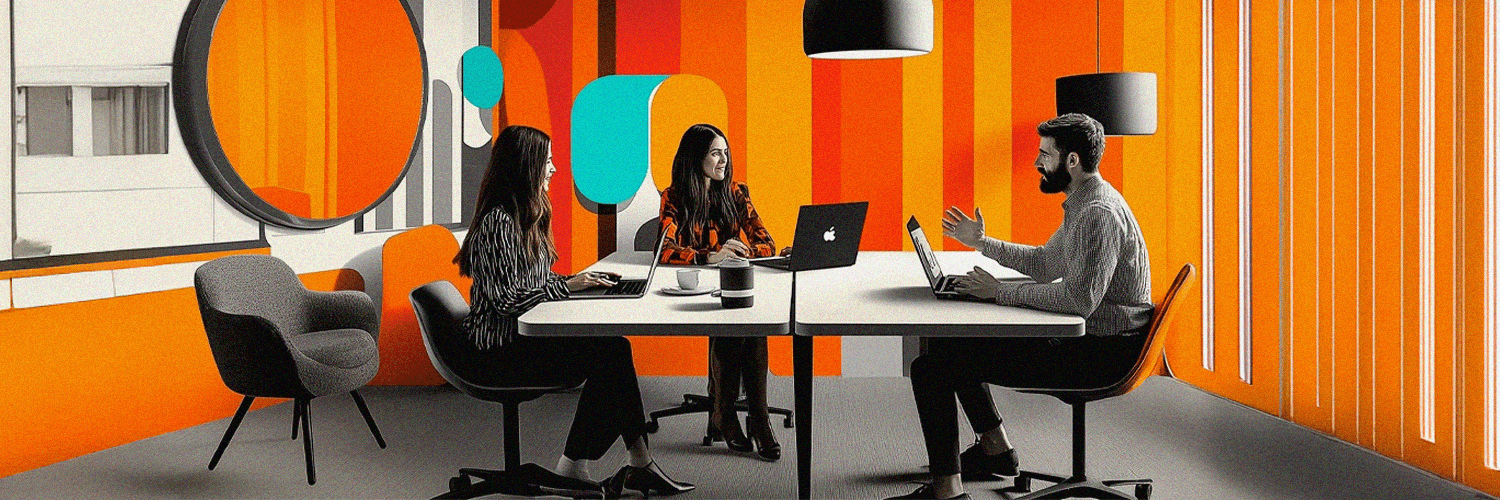If you want to drive business value by getting your employees more collaborative, more engaged, and more productive, building a great workplace experience is crucial.
It creates the ideal work environment for them to do their best work.
But despite its critical role, there still are a lot of widespread misunderstandings about what the workplace experience really is.
And about how you create a good one.
In today’s post, you’ll learn exactly what these myths and misconceptions are. So you can (re)start building your workplace experience… the effective way.
Let’s dive right in.
TD;LR:
- Workplace experience is often reduced to perks. This leads to the misconception that it creates company culture on its own.
- Misunderstanding workplace experience leads to ineffectiveness, as true engagement stems from a strong company culture.
- A clear understanding of what workplace experience really is ensures employee engagement and productivity.
- The myths around workplace experience range from the one-size-fits-all approach to the misconception that it is all about technology
- The solution? A people-centric approach to workplace experience based on actively listening to your employees, addressing their individual needs, and fostering a sense of belonging
The Widely Misunderstood Landscape of Workplace Experience
The workplace experience has almost as many definitions as organizations wanting to reap the “dividends” that come with a great one: productivity, employee satisfaction, and organizational success.
So, it has slowly grown into a vague term applicable almost to anything and everything.
And in too many companies approaching, developing, and running a workplace experience has become a mere collection of perks and benefits.
A checkbox.
This leads to the most widely spread misconception about workplace experience of them all: that it’s supposed to create an engaging, fun, and unique environment – a company culture – on its own.
Furthermore, too often, there’s a blurring line between workplace experience and employee experience. Which goes up to the point of confusing one over the other and using the two terms interchangeably.
Since… well… They both refer to experiences people have at work.

Why a Clear Understanding of Workplace Experience Is Crucial for Leaders
Because misunderstanding what workplace experience really is – and implementing a bad workplace experience strategy – will only lead to employees feeling that the company’s not:
- sincere
- authentic
And all your efforts – making room for a pool table in the office space, offering free shuttle services, gym memberships, free lunches, free nutrition education programs, a 4-day work week, and other workplace benefits – are in vain.
As they fail to drive the significant outcomes that a great workplace experience can drive:
- more productivity
- more engaged employees
- happier and more satisfied employees
A good workplace experience makes your employees feel empowered to do their best (meaningful) work.
And free to choose how, when, and where they work so they can reach their full potential.
By not having a clear understanding of workplace experience, leaders risk falling into the pitfall of expecting the workplace experience to create the company culture.
As it should be the other way around.
It’s a company culture – based on personal growth and mutual respect – that a great workplace experience stems from.
And drives its authenticity and effectiveness from.
In other words, the workplace experience is the only element of the company culture itself that employees can experience through their senses.
And the metric they use to gauge the company culture's authenticity. And sincerity.
By simply:
- offering healthy food options at work
- placing living plants in the office
… without anchoring them into a strong culture that proves the company is sincerely committed to its employees' health and wellbeing – will only act as the… elephants in the room reminding people of how inauthentic the company is.
Dispelling 5 Myths About Workplace Experience
Going back to the actual goal of this blog post – to expose to you the most common misconceptions about workplace experience – here are the 5 most widely spread ones:
Myth #1: One Size Fits All
Too many leaders strive to craft the best workplace experience strategy.
Without questioning themselves a quite basic, yet crucial question: “Best for whom?”
Or, if they do ask themselves that, they come up with answers like “for the employees”.
Or (even worse) “for the company”.
But both are equally wrong answers.
“The employees” are:
- Those with caregiving duties
- Those with disabilities
- Those working remotely in home offices
- Those individual contributors part of highly autonomous teams, who’re head-down most of their workdays (that the busiest collaboration space wouldn’t help them do their best work)
- Those innovation-based teams that are all about experimenting, failing fast, and collaborating closely
- …
Your “employees” as a whole are different individuals.
With different needs. And different purposes they want to achieve.
Therefore, it might not even be 100% accurate to talk about THE workplace experience within your organization.
But about the workplace experiences there.
Otherwise, implementing a unique workplace experience turns into a missed opportunity – to increase talent attraction, boost company productivity, and enhance employee wellbeing.
Myth #2: Workplace Experience Is the Same as Customer Experience
You’d use a customer journey map to pinpoint all the key experiences that a client has with your company throughout his lifecycle.
So you can focus on those “moments that matter”. And operationalize accordingly.
Therefore, you can use the same approach to map all the “moments that matter” in an employee’s journey throughout his workday, right?
Actually, no.
Here’s why:
- A customer journey map is an accurate inventory of the majority of a customer’s key experiences with your company. But this type of a “map” used as a blueprint for developing your workplace experience will fail to include ALL the stages of an employee’s journey. Instead, it’ll include only a small fraction of them.
- When developing an employee journey map it’s you who assesses the potential of certain experiences to be labeled as “moments that matter”. When it should be the employees who make this assessment.
- By approaching your customer experience and your workplace experience the same way, you assume that customers and employees have the same relationships with your organization. When, in fact, for the customers, they’re mostly transactional, while for the employees they’re far more complex and longer-lived.
The consequence of this misconception?
You fail to focus on precisely those moments that matter the most for your employees when you develop, and then implement your workplace strategy.

Myth #3: Workplace Experience Is an HR Issue
This is only partially true. Because these days we’re witnessing a shift of focus in the facility management sector.
The new role of the facility managers is no longer exclusively that of… well… managing facilities. And keeping operational costs in check.
Due to the increasing recognition of the impact the workplace environment has on job satisfaction and employee performance, facility managers are now expected to curate workspaces that:
- foster innovation
- support collaboration
- boost productivity
- enhance employee satisfaction and wellbeing
In short, the HR department is no longer entirely responsible for the workplace experience delivered within an organization.
As the facility managers of today are expected to create more holistic workplace experiences, instead of merely managing office spaces.
They’re expected to create work environments that bring value to both the organization and its employees.
Myth #4: Workplace Experience Only Concerns Employees
More and more companies are moving towards a more agile workforce these days.
In consequence, they’re hiring contingent workers – freelancers, project-based workers, contractors, etc. – to cope with change and uncertainty. With fluctuating workloads and seasonal demands.
Therefore, it’s only common sense that they should include ALL types of workers when developing their workplace experience strategy.
Not just their full-time employees.
Otherwise, they would cut off a significant part of people contributing to their operations.
And exclude even other types of experiences that the workplace experience delivered in your organization has a direct impact on.
Like the visitor experience, for example.
In short, if you include employees only in your workplace experience strategy, you overlook the needs and expectations of all those guests – business partners, new candidates, potential new clients – whose experience with your brand can bring or fail to bring you the business outcomes you’re looking to achieve.
Myth #5: Workplace Experience Is All About Technology
Company culture, office space, and technology. These are the 3 pillars of a workplace experience.
And we should add “interactions” as well.
Although technology – workplace software – does play a big role in improving the workplace experience:
- It’s just one aspect of the work environment
- It’s most valuable because of the data it gives access to
… To essential, real-time data about how workplaces are being used. Data that can then be turned into valuable decisions on:
- Optimizing employees’ workspaces (focusing on those aspects of the workplace that are truly important for them)
- Streamlining their operations and reducing manual tasks (e.g. booking conference rooms)
- Identifying areas where employees might need additional training
One such workplace experience platform is YAROOMS, which provides you with the workplace analytics you need to create those work environments that serve your employees.
And bring them value.
Strategies for Leaders to Navigate the Complexity of Workplace Experience
Leverage Office Utilization Data
Rely on workplace analytics to gain a clear understanding of how your office space is being used.
… So you can create better experiences at work.
For instance, if data shows that meeting rooms are almost always overbooked, you might want to consider converting other, underutilized office spaces into meeting rooms.
Data will help you identify those specific spaces.
Collect Feedback… Regularly
Whether it’s through 1-on-1 interviews or surveys (or all-hands meetings), you’ll want to listen to your employees. And gather continuous feedback from them.
Let them tell you which are those obstacles standing in your way of delivering a great workplace experience.
And what are those areas of improvement you should focus on.
Whether that’s:
- access to specific tools to get their (best) work done
- a working schedule that’s flexible enough to accommodate both their work life and personal life needs
- A work environment that better facilitates collaboration among team members; or between managers and their teams.
Define What a Great Workplace Experience Looks Like
… For you and for your employees.
Then, create a hypothesis for the business outcomes and benefits you expect it to help you achieve.
And identify the metrics you’ll use to measure the success of your implementation.
Metrics like:
- Wellbeing scores
- Employee surveys
- Levels of productivity
- Sustainability metrics
Good Workplace Experience = People-Centric Experience
It’s about showing people that you care about them. That they matter within the workplace
How do you create this human-centric workplace experience?
It all starts with listening, as Simon Fenton-Jarvis says during her conversation with Cosmin Patlageanu, in our latest Workplace Whiz podcast.
- Take the time to listen, actively, to what your employees’ experience needs and individual expectations are.
- Once you’ve collected your people's expectations, current struggles, and individual needs, commit yourself to improving things. Or as Simone puts it, you need to “care about what happens next.”
And those improvements can range from:
- giving your employees real choice options
- to adapting the office space so that it meets all the individual needs (not just those of collaboration, for instance) and all the different roles in your company
- to communicating the actual value and purpose – i.e. which of their problems it solves – that new workplace technology you’ve introduced at the workplace will have on their workplace experience(s).
… Instead of merely expecting them to use it just because it’s there.












